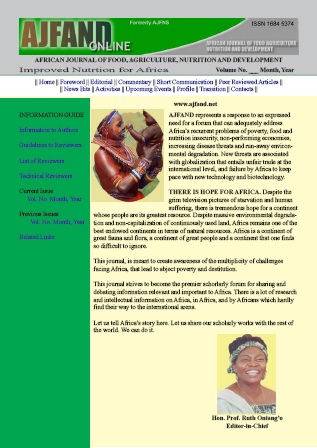
|
African Journal of Food, Agriculture, Nutrition and Development
Rural Outreach Program
ISSN: 1684-5358
EISSN: 1684-5358
Vol. 14, No. 2, 2014, pp. 8663-8675
|
 Bioline Code: nd14018
Bioline Code: nd14018
Full paper language: English
Document type: Research Article
Document available free of charge
|
|
|
African Journal of Food, Agriculture, Nutrition and Development, Vol. 14, No. 2, 2014, pp. 8663-8675
| en |
FOOD VARIETY, DIETARY DIVERSITY AND PERCEIVED HUNGER AMONG LACTATING WOMEN (0-6 MONTHS POSTPARTUM) IN A LOW SOCIO-ECONOMIC AREA IN NAIROBI, KENYA
Ongosi, A.N.; Gericke, G.; Mbuthia, E. & Oelofse, A.
Abstract
Breastfeeding has profound benefits for the child and has always been the gold standard for infant feeding. It is also an integral part in the physiologic completion of the reproductive cycle of mammals, including humans and the most energetically demanding phase of human reproduction. Therefore, it is important to determine the nutritional status of lactating women and guide them to optimal health since depleting maternal nutrient stores during lactation poses a risk of malnutrition to the mother. This study was conducted among lactating women to assess domestic hunger, food variety and dietary diversity in order to obtain information that can be used in nutrition intervention programs for optimising breast feeding. It was a descriptive cross-sectional survey carried out at Mbagathi District Hospital which is located at the edge of Kibera slum area (Nairobi). Convenience sampling was used in selecting 120 lactating women who volunteered and consented. The hunger scale was used for assessing domestic hunger and a 24 – hr recall (NFCS, 1999) was analysed for food variety and dietary diversity. Perceived hunger corresponded with narrow food variety and dietary diversity. The women had a mean Food Variety Score of 6.6 (±2.0) and Dietary Diversity Score of 4.3 (±1.0). The mean adequacy ratio (excluding niacin) was 0.74. The lowest median nutrient adequacy ratio (NAR) for calcium was (0.41) and folic acid (0.59). The NAR for energy was 0.62. The highest frequency of consumption (100%) was from cereals, tubers/roots, other vegetables and oils/fats. Vitamin A rich vegetables/fruits (6.6%) and dairy products (1.7%) had the lowest frequency of consumption. Overall, 35.8% of households were food secure while 64.2% were either hungry (5 or more positive responses) or at risk of hunger (1-4 positive responses) (36.7% and 27.5% respectively).There seems to be a need for well designed nutrition intervention programs focusing on nutrient intake from culturally acceptable and affordable foods to increase dietary diversity of lactating women in this low socio-economic area, which will eventually improve their nutritional status.
Keywords
lactation; dietary diversity; food variety
|
| |
© Copyright 2014 - African Journal of Food, Agriculture, Nutrition and Development
Alternative site location: http://www.ajfand.net/
|
|
